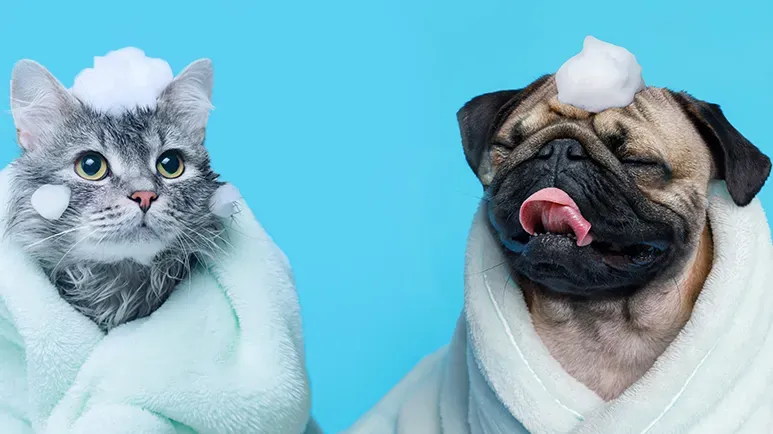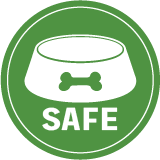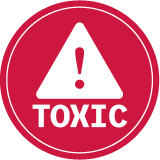Splish, Splash — Your Pet's Having a Bath!
From choosing the right products to drying your dog like a pro, here's everything you need to know to make bath time safe, stress-free, and effective.

STORY AT-A-GLANCE
- Bath time removes dirt, allergens, and parasites while offering a chance to check for skin problems, reduce shedding, and improve your pet's comfort, mood, and hygiene overall
- Bath frequency depends on your pet's coat type, lifestyle, and overall health. From once a month to just after muddy play, your pet's needs are uniquely individual
- Using pet-safe shampoo, non-slip mats, lukewarm water, and gentle tools helps create a calm environment that supports your pet's trust and well-being throughout the process
- Brush before washing, clean the body first, use a damp cloth for the face, and rinse thoroughly to avoid irritation. Each step protects your pet's skin and nerves
- Wrap up the experience with a towel, a treat, and soothing words. Over time, this builds trust and transforms bath time into a relaxed bonding ritual
Bath time can be a fun, splashy adventure for some pets, filled with bubbles and extra attention. For others, it's a stressful experience they'd rather avoid. However, regardless of how your furry friend feels about it, regular bathing is an essential part of maintaining their health and hygiene.
Far beyond simply cleaning away dirt and odors, bathing plays a crucial role in skin care, comfort, and even emotional well-being. However, it's essential to approach this task with care, patience, and a thorough understanding. Pets are not small humans. Products and methods that work for us can be harmful to them, especially when it comes to shampoos, tools, and bathing techniques.
Why Bathing Your Pet Matters
Bathing a pet serves far more than cosmetic purposes. It helps remove accumulated dirt, allergens, dead skin cells, and even parasites from their coat and skin. A well-timed bath can ease itching, reduce shedding, and contribute to a healthier, shinier coat.
Regular bathing also provides an excellent opportunity to check your pet for lumps, bumps, skin irritations, or signs of fleas and ticks. By incorporating bathing into your pet's grooming routine, you enhance not only their physical health but also their emotional well-being. Clean pets are more likely to relax, rest well, and socialize happily.
However, this doesn't mean more is always better. Overbathing can dry out your pet's skin, strip away protective oils, and cause discomfort. Frequency matters — and so does technique.
How Often Should You Bathe Your Pet?
One size doesn't fit all when it comes to bath frequency. Most dogs do well with a bath about once a month or once every three months. But that can vary depending on their breed, coat type, health condition, and activity level. Here's a simple guide:1,2
- Active dogs that love to roll in the dirt or swim in lakes might need a rinse after each adventure.
- Dogs with allergies or skin conditions may need more frequent or medicated baths (always check with your vet).
- Short-haired or indoor pets may go longer between washes — unless they've found something smelly to roll in. Somewhere between every one to three months is ideal.
- Medium- and long-coated dogs should be bathed every four to six weeks.
Meanwhile, cats and small pets, such as hamsters or guinea pigs, generally require fewer baths, and some may not need them at all unless they get into something messy. Cats, in particular, are usually fastidious self-groomers and may not require regular bathing unless they are elderly, obese, or have medical issues that prevent them from grooming effectively.
An article in USA Today says, "When in doubt, wash your pet when they get grimy. If you spot dirt, feel something sticky, or smell a funk, take it as a cue to get that pup in the bath."3 Remember — no bath can "wash away" your pet's natural scent or shedding completely. A mild, natural bath routine is about balance, not overdoing it.
Preparing Your Bath Time Supplies
Before you invite your pet into the tub, it is crucial to be fully prepared. The right environment and equipment can make all the difference in ensuring bath time is safe, calm, and efficient. Here's a recommended checklist for bath day:4
- Pet-safe shampoo — Choose a gentle, pH-balanced formula made specifically for animals. Avoid human shampoos and harsh chemicals
- A rubber mat or towel — Place in the tub or sink to help your pet maintain their footing
- Cup or sprayer for rinsing
- Washcloth
- Soft towel(s)
- Brush or comb
- Ear protection or cotton balls — These are helpful if your pet dislikes water near their ears
- Treats to use for positive reinforcement throughout the process
Optional but helpful additions include a soft sponge or washing mitt and a hairdryer for long-coated animals.
A Step-by-Step Guide to a Calm, Clean Bath
With your supplies in hand and your pet nearby, you are ready to begin. Follow these simple, veterinarian-approved steps for a gentle and effective bath.
- Brush before you bathe — Brushing your pet's fur removes loose hair, dirt, and tangles, which allows shampoo to reach the skin more effectively.5 This step is essential for long-haired or double-coated breeds. Mats and knots can become worse when wet and may even trap moisture against the skin. Brushing also helps reduce the amount of fur that ends up clogging your drain.
- Create a calm environment — Your pet takes emotional cues from you. If you approach bath time calmly and confidently, they're more likely to cooperate. Speak softly and offer gentle praise as you guide them into the bath area.
Using a non-slip mat or towel will help them feel secure and stable. If your pet is especially nervous, consider using a lick mat smeared with peanut butter or a favorite treat to help keep them occupied and calm.
If possible, enlist a helper, especially if you have a larger dog or an anxious pet. One person can focus on holding and comforting the pet while the other handles washing and rinsing. - Gently wet the coat — Start by slowly wetting your pet's body, beginning at the base of the neck and working backward. Avoid splashing or spraying directly on the head. A soft cup or low-pressure sprayer is less intimidating than a high-powered showerhead.6
Ensure the coat is thoroughly soaked before applying shampoo. This allows the product to lather properly and reach the skin. - Apply shampoo and massage — Use a small amount of pet-safe shampoo and work it into a light lather, massaging it gently into the coat in sections. Start at the neck and work your way down to the tail. Focus on areas prone to collecting dirt, such as the paws, underarms, belly, and the back of the ears.
Take your time. This is an excellent opportunity to relax with your pet and check their skin for anything unusual. Massaging also improves blood circulation and helps loosen dead skin cells. Let the shampoo sit for a few minutes if the label recommends it, especially for medicated formulas. - Wash their face with caution — Never pour water over your pet's head. Instead, use a damp washcloth to clean around the muzzle, eyes, and ears gently. If needed, use a very small amount of mild shampoo or a face-specific cleanser on the cloth.7
Take care not to get any product or water into the eyes, nose, or ears. Soap and moisture in these areas can lead to irritation or infection. Look out for signs of stress, such as lip-licking, yawning, trembling, or trying to escape. If your pet seems overwhelmed, pause and offer reassurance before continuing. - Rinse thoroughly — Rinsing is one of the most critical steps in the bathing process. The shampoo left behind can irritate the skin, cause dryness, or attract dirt more quickly.
Use clean, lukewarm water to rinse from the neck down, making sure to get between the toes, under the belly, and into all the folds and crevices. Continue rinsing until the water runs completely clear.
If your pet has a dense or water-resistant coat, you may need to rinse several times to ensure all shampoo is removed. Don't rush the rinse; residue causes itching, so rinse thoroughly. - Drying and aftercare — Once your pet's coat is fully rinsed and the shampoo removed, gently guide them out of the tub and wrap them in a towel. Pat their fur dry instead of rubbing, as rubbing can create tangles or irritate sensitive skin.
For long-haired breeds or pets with thick coats, consider using a second towel or a pet-safe blow dryer in a low, cool setting. If you use a dryer, keep it moving and never aim it at their ears or face.
Use cotton balls to lightly dry the outer part of their ears. Never insert anything into the ear canal. Moisture trapped inside can lead to infections. Place your newly bathed pet in a clean, quiet area until they are completely dry. - Reinforcement — Always end bath time on a positive note. Praise your pet warmly and offer a treat or a favorite toy. This helps build a positive association with bathing and makes future bath times less stressful.
Even if it isn't always a perfect experience, your pet will remember that they were rewarded afterward, and that builds trust.
Remember These Special Cases When Bathing
Some dogs, depending on their age, health conditions, or body type, may have specific considerations that affect how and when they should be bathed:
- Puppies — Give them short, warm baths with gentle shampoo. Avoid overbathing their sensitive skin.
- Senior pets — Softer touch and extra non-slip support are key. They may tire more easily, so you may need to give them quicker baths.
- Allergy-prone dogs — Look for hypoallergenic shampoos or those recommended by your vet.
- Hairless or short-coated dogs — These breeds require more skin moisturization and protection post-bath.
Make Bath Time a Bonding Time
Bathing your pet isn't just about hygiene; it's about love, care, and building trust. When you take your time, use the right equipment, and approach the experience with patience and positivity, bath time becomes a meaningful, stress-free moment between you and your furry friend.
So next time your four-legged friend finds a mud puddle or rolls in something questionable, don't fret. You've got the knowledge to handle it like a pro.










